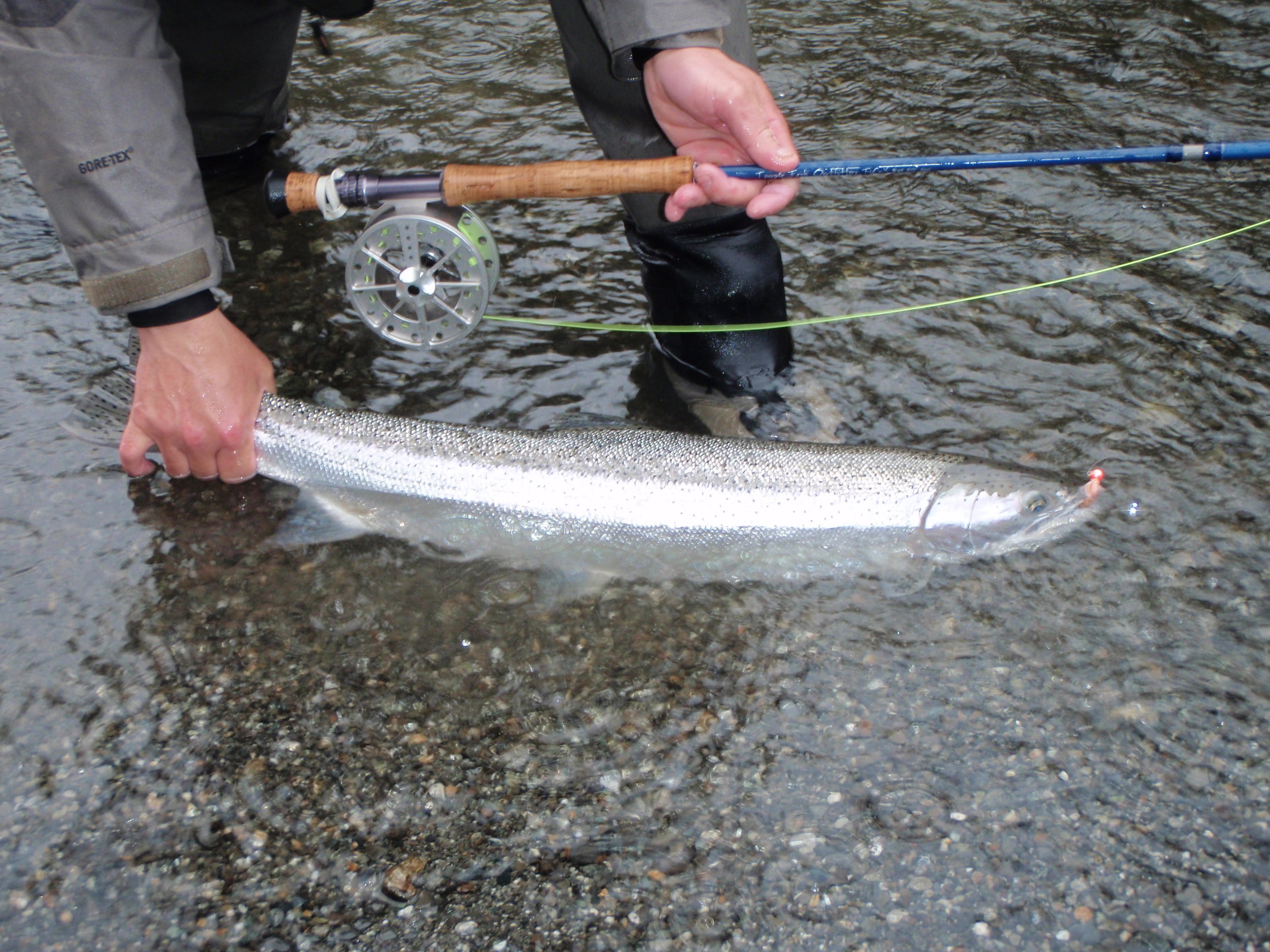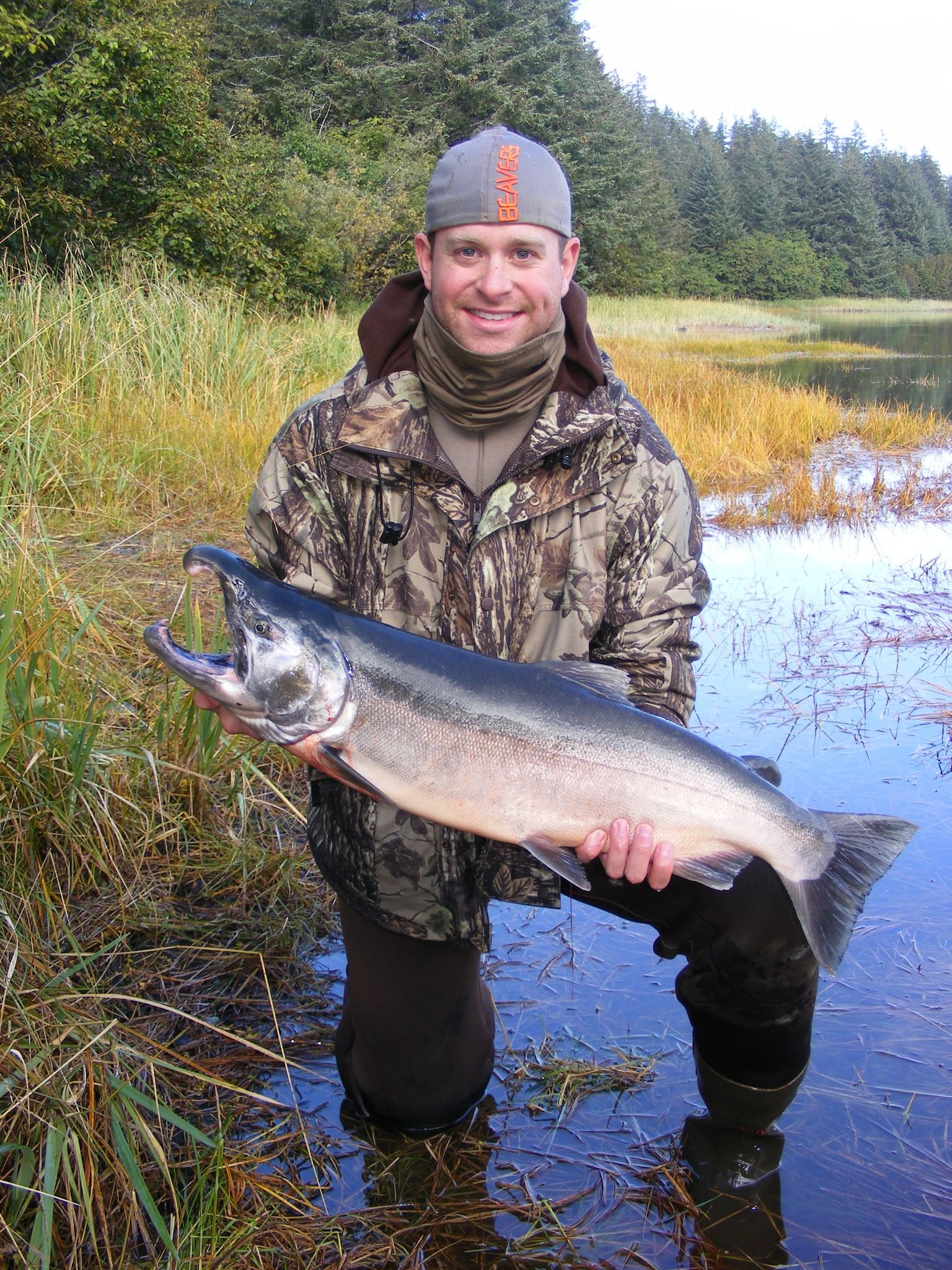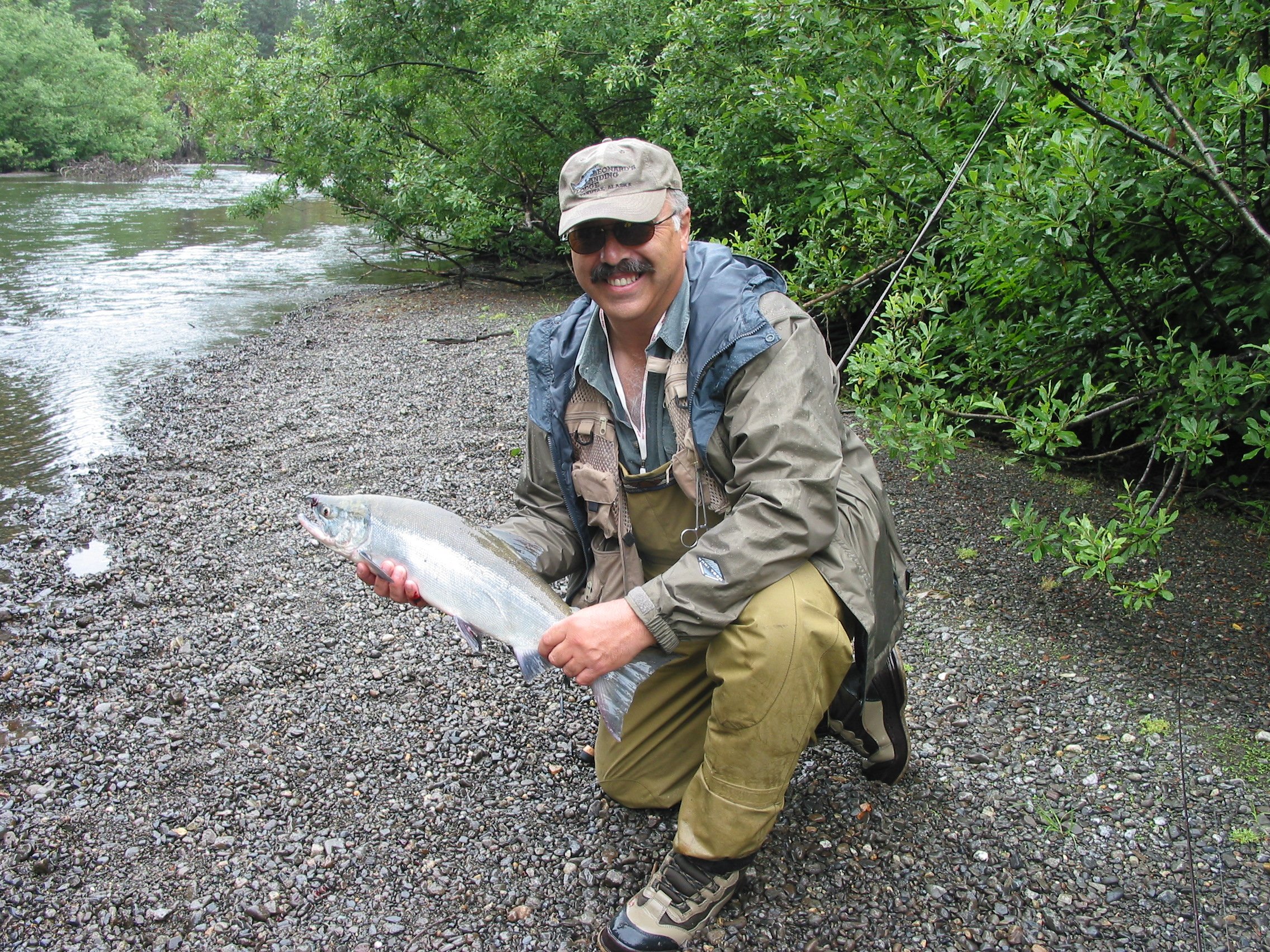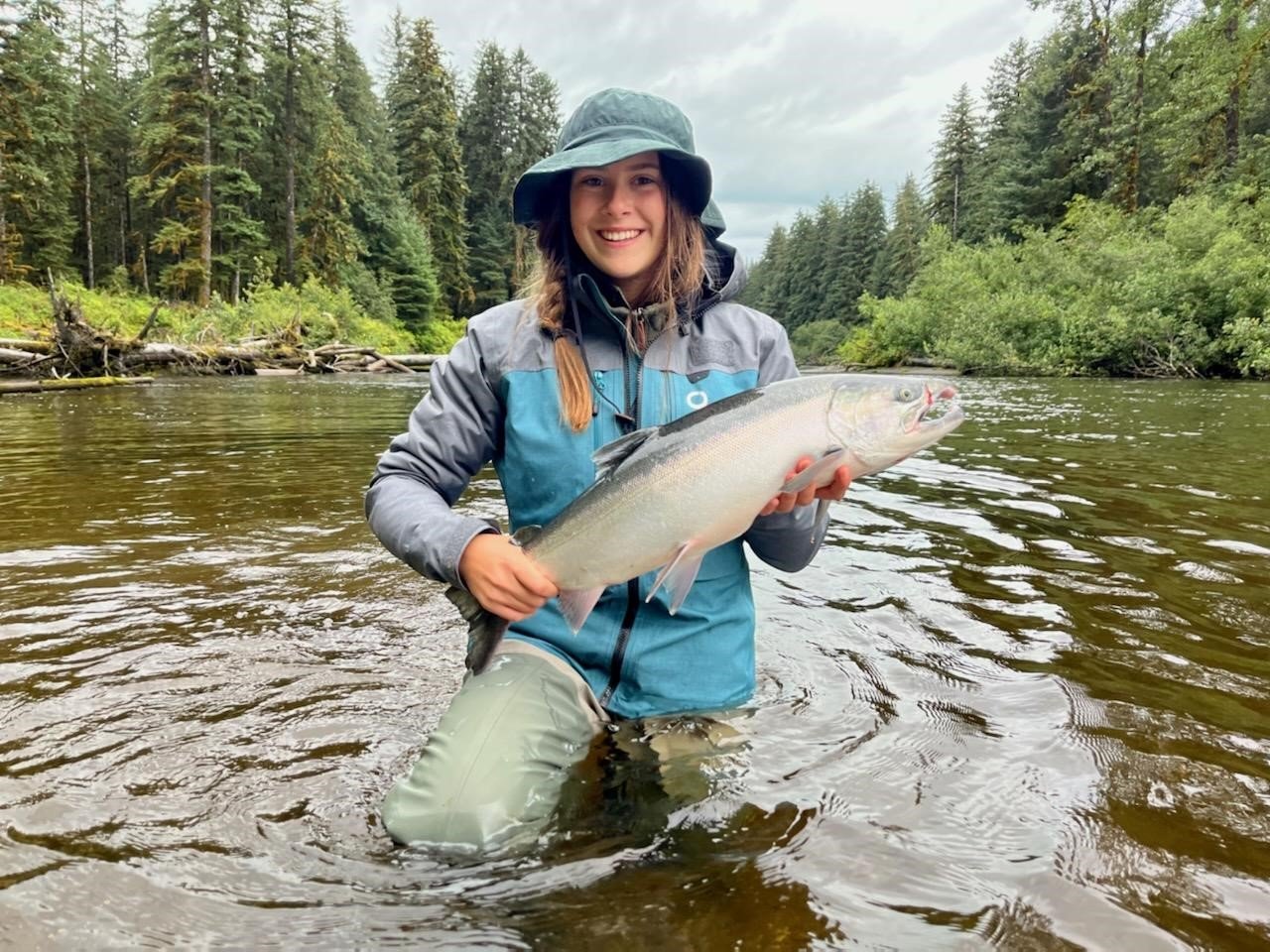
Freshwater Fishing


























DIY Freshwater Fishing
The two Situk River access points at the Nine Mile Bridge and the Situk Landing are less than a half-hour drive from the lodge. Explore the river by way of a rental drift boat, wading, or book a guided trip.
Do you want to know where to go fishing, what gear to bring, and some tips for a successful fishing trip?
Check out the drop-down tabs below!
-
The Situk River is a popular, beautiful, and healthy fishery with runs of all five species of salmon, as well as, steelhead, and dolly varden. The most targeted fisheries are the sockeye (red), coho (silver) salmon, and the large spring wild steelhead run. The Situk River is a smaller river with numerous log jams and a large amount of woody debris in the water. The river bank is loaded with thickly wooded banks. It is best fished by wading. Shallow gravel-runs switch back and forth in deep, slow water at bends and log jams. The water is usually clear; however, the clarity and flow can change rapidly with heavy rains, and the lower section of the river (above the Situk Landing) is affected by ocean tides.
-
Coho, sockeye, and pink salmon runs are usually very rewarding. Anglers walk away from their day on the river with plenty of fish tales and fillets to share with friends and family!
Chinook (king) salmon fishing is restricted in the Situk River and only opened if the fish counts are high enough to meet spawning objectives. Chum (dog) salmon, while present in the river ecosystem, are rarely caught in the Situk.
The wild spring steelhead run is one of the best in the state, and devoted anglers have the potential to catch and release double-digit numbers of fish in one day. Run size combined with the size and accessibility of the river makes the Situk a popular and very successful location for the DIY angler.
Fishing success can depend on many factors. The information below will help you come prepared and ready to make the most of your Alaskan adventure!
Don’t hesitate to contact us regarding gear and equipment or for a conditions update.
-
The Situk is a no-bait, single-hook fishery. Make sure to swap your trebles for siwash hooks.
We recommend wearing waders. At the minimum, you will need knee-high rubber boots for bank fishing and hiking the muddy trails. Felt-soled wading boots are not allowed in Alaskan waters to prevent the introduction of invasive species.
Bring plenty of lures and tackle. The Situk is a snag factory, and you will lose lots of gear, no matter your experience level.
The entire Situk is spawning habitat. Avoid walking on redds and don’t target actively spawning fish. All Situk River fish are wild from natural reproduction within the river system.
Alaska Fish and Game makes in-season changes to published ADFG Fishing Regulations through Emergency Orders. Be sure to check for any changes, including fishery openings and increased bag limits.
ADFG Fishing Regulations: https://www.adfg.alaska.gov/index.cfm?adfg=fishregulations.se_sportfish
ADFG Emergency Orders. https://www.adfg.alaska.gov/sf/EONR/index.cfm?ADFG=region.R1
Please purchase your license ahead of time. We recommend creating an account on the Alaska Fish and Game website and using the eSigned license format. It will allow you to have a signed digital license on your phone and eliminates the need for a paper license. You can also purchase and print a paper license from the website. https://store.adfg.alaska.gov
-
Peak Run Timing: April 20-May 15
General Information: Fish average 28-32 inches and fight hard. A finesse presentation can be significant with clear water and lower river flows, and a fluorocarbon leader is highly recommended. Proven Steelhead tactics work well here, and the river allows for excellent sight fishing opportunities when walk wade fishing.
Spinning and bait-casting:
Rods usually consists of 7.5-9.5 ft medium power rods anywhere in the 8 to 20-pound test-line rating range with a moderate or fast action. Extra long rods are not needed. A rod with a softer tip and good backbone is ideal. You’ll want the ability to put some pressure on stout, chrome fish to keep them out of the wood.
Reels must have a smooth drag and should be spooled with at least a 15-pound test monofilament or 20 to 30-pound braided main line. Low profile level winds or 3000-size spinning reels spooled with 20-pound braid are ideal and give reasonable casting distance with lighter presentations.
Spinning tackle: Steelhead jigs, plastic worms on a jig head, and beads fished under a bobber are very effective. Spinners, spoons, and plugs will catch fish and allow you to cover water, get under logs, or intercept fresh fishing moving up the river on the lower end. Cerise pink is the go-to color; however, the color bite can change quickly. Purple, blue, orange, red, black, or any combination of these are good options to have with you. Fixed or sliding floats, 1/8-1/4 ounce jigs, 6-inch worms, size 3-5 spinners, and 3/8-1/2 ounce spoons. Don’t forget your bobber stops, inline weights, split shot, swivels, and 12-pound fluorocarbon leader.
Hook Selection: These Steelheads are firm fish, and good hook selection is essential. The typical bronze wire hooks will bend. Get quality 2x or 3x jig hooks in sizes 1/0-3/0, and 2/0-4/0 siwash hooks for lures from Gamakatsu or Mustad. See bead info under fly tackle below.
Fly-Fishing:
Rod and Reel: Fly fishing rods from 7 to 10-weight are used. You’ll want a rod with the backbone to handle feisty fish and steer them out of current and log jams, as well as land them in a reasonable time so as not to exhaust the fish. Reels should have a solid drag and hold 100 yards of 20 to 30-pound backing.
A floating line will cover you for most situations. Having a sink tip or medium-rate sinking leaders may be helpful, depending on your fishing style and fly.
Bobber or drift-fishing with beads, egg patterns, and yarnies is the most common tactic, but streamers, nymphs, and swinging are also effective.
Fly Tackle: Size 2-6 Dolly Llamas, egg-sucking leeches, Liquid Wrenches, and similar salmon and steelhead streamers or nymphs, swinging flies, glo bugs size 2, yarnies tied on 2-1/0 octopus hooks. Cerise pink is a good standby, but any combination of these colors is worth having in your arsenal; purple, blue, red, orange, and black.
Bead sizes range from 8-16mm, with 12-14mm being the most commonly used. Pink, orange, natural roe, or any variation of molted versions will work with size 2 trout bead or Gamakatsu Glo Bug hooks. Remember your bead pegs, split shot, bobbers, and fluorocarbon tippet or leader in a 10 or 12-pound test.
-
Peak run timing: June 25 - July 20
General Information: Fish average 4-8 pounds and put up a hard fight for their size. Also known as red salmon, these are some of the best eating but most challenging-to-hook salmon. They do not readily or commonly strike flies and lures and are very difficult to catch with traditional methods.
Set-Up and Technique:
The most effective technique is called lining, flossing or flipping for reds. Learning this technique is far more essential than your fly or lure selection. Your main line runs to a swivel with a fixed sinker just above it (generally 1/4 to 1/2 ounce weight dependent on current and depth), a 3-5 foot leader runs to a simple fly or octopus hook with an egg loop and piece of yarn (yarnie), which allows you to see your drift in the water. A 45-degree short upstream cast will enable you to drift your leader in the bottom 6 - 10 inches of water perpendicular to the fish swimming upstream in front of you. Be sure to keep slack out of the line as it drifts. As fish push up the river in large groups with their mouths open, the leader runs into their mouth, which you can feel. Set the hook, drawing it into the side of their mouth, as they continue upstream. No jerking or jigging of your fly through the water is needed. With some practice, and adjustments to your setup to get the correct drift, you’ll have your limit quickly when the fish are moving.
Sockeye generally run upriver in the shallower, faster water close to shore rather than staying deep like other species. They are accessible without wading in many spots.
The following is taken directly from ADFG Sport Fishing Regulations, “It is unlawful to intentionally snag or attempt to snag any fish in fresh water. Fish unintentionally hooked elsewhere than the mouth must be released immediately. A snag means to hook a fish elsewhere than in the mouth.”
Spinning and casting rods: Rods 7 to 9-feet in length, medium or medium heavy power within the range of 12 to 25-pound line ratings with medium fast or fast actions work well.
Reels: Spinning reels in the 3000-4000 size range, level winds, and bait casters with a decent drag and 15 to 30-pound main line will all give you the ability to get these strong fish in quickly, bank land them, and get back in the water while they are still running. Don’t go light on line and leader as these are feisty fish. A finesse presentation is not essential, and long casts are unnecessary.
Fly rods: 8 to 10-weight rods are recommended, along with a reel spooled with floating line and 100 yards of 20 to 30-pound backing. Fly rods have the advantage for Sockeye as the short flip casts and drifts are more natural and easier to cast with a fly rod.
Intermediate and fast sink tips can replace the need for a sinker, and no tapered leaders are needed. Running a sink tip, or a rod length of 30-pound mono with spilt shot, to a small (size 8) barrel swivel attached to 3 - 5 feet of 15 to 20-pound leader and yarnie or fly is all you’ll need.
Lures and flies usually consist of a yarnie tied on a hook (size 1-2/0) or simple coho flies.
Gamakatsu sells pre-tied sockeye rigs if you don’t want to tie your own.
Heavier leader, 15-30 pounds, is recommended and you want plenty of weights (split shot, inline, and rubber core sinkers all work), flies, and tackle as it is easy to get snagged and break off.
-
Peak run timing: July 25-August 15
General Information: Averaging 3-5 pounds, pinks, also known as humpback “humpy” salmon, spawn in large numbers. This makes for non-stop-action fishing. Although less sought after for table fare, pinks readily hit lures and flies, fight well, and are fun to catch. This is a notable species to introduce a new fisherman to the sport, could make for a great family experience, or could inspire a beginning fly-fisherman. Depending on the year and ecological circumstances, late sockeyes could still be entering the river, and early silvers could also be intermingled with the pinks in August.
Spinning and bait casting: Recommended rods could consist of any setups listed here for other species. A medium power 6.5 to 7-foot bass and trout rod would work equally well. Low-profile bait casters and 2500-3000 size spinning reels spooled with a 12-15 pound line will do the trick.
For the fly fisherman: A 7-weight rod is ideal for these fish. A 6-weight will get you by, and any heavier rod will suffice. A tapered leader with 1x tippet to a flashy pink streamer in size 4 or 2 will get you fishing. Any salmon or steelhead streamers with a little flash and suitable action will keep you fishing. You do not need to be too picky here.
-
Peak run timing: August 15-Sept 25
General Information: Coho, commonly called silvers, average 8 - 12 pounds. These salmon are hard-hitting, hard-fighting, exciting fish to catch. The Situk River is well known for its run of silvers. Light gear and tackle will not work well for these fish. They like to swim for the log jams when hooked and are running when river flows are commonly higher.
Spinning and casting rods: We recommend medium heavy or heavy power rods, 7 to 9-feet long, 15 to 30-pound line rating with a moderate fast or fast action to leverage fish over 10 pounds. Pair it with 4000-size spinning reels or level wind bait casters with an excellent drag to sufficiently fight these larger aggressive fish. Spool the reel with a 20-pound monofilament or 30-pound braided line.
Spinning tackle: Spinners, twitching jigs, and spoons are all used. Spinners are the most common and very effective. Try Blue Fox Vibrax, Mepps, and Kodiak Customs in sizes 4 and 5 with or without skirts. Twitching jigs (1/2 ounce) work well in suitable waters, and 1/2 to 3/4-ounce Blue Fox Pixies, Mepps Cyclops, and similar spoons offer reasonable casting distances to cover water when fish are moving up. Chartreuse, orange, pink, purple, blue, and black are all proven colors.
Bring a 20-pound leader, plenty of lures, and quality snap swivels. Make sure to swap the treble hooks for single hooks.
Fly Fishing: You will want to use a heavier 8-10 weight rod, and a quality reel with a good drag that will hold 100 yards of 30-pound backing. A floating line and fast sinking leader will cover most situations when stripping or drifting for silvers in slower, deeper water. Tapered leaders are not required. A section of heavy mono to a leader of 15-20 pound fluorocarbon will do.
Fly tackle: Generally consists of streamers with cone heads or weighted eyes to get down to the fish. Beads, flesh flies, and leeches can be drifted along deep, slow streams. Size 2 or larger Dolly Llamas, Clouser Minnows, Egg-Sucking Leeches, and Coho Comets are just a few effective patterns. Pick a fly with a little flash in it with any combination of these colors; green, chartreuse, orange, red, pink, purple, blue, and black, and hang on!
-
Bears: Salmon in the rivers mean bears on the bank! At any time, black or brown bears can be encountered along the Situk River. Bear spray is available for loan from the lodge office. Fish with a buddy and stay alert. More information on Alaskan bears and safety information can be found on the ADFG website. http://www.adfg.alaska.gov/index.cfm?adfg=livingwithbears.bearcountry
Weather: The standard forecast is rain with a chance of bears. Good rain gear and synthetic layers will help make your trip more enjoyable if the weather doesn’t cooperate. Yakutat doesn’t get much attention from forecasters, but the best weather info can be found on the NOAA website. https://forecast.weather.gov/MapClick.php?lon=-139.66045&lat=59.50916#.Y45Y8C-B0UQ
Safety: Yakutat is a remote town with few emergency resources and no hospital. Help may not be a phone call away. Cell service is limited to AT&T and is spotty along the river. Satellite phones and messaging systems are good options. Trails are generally muddy and unmarked, and river flows can change quickly. Come prepared. Stores, gear, and supplies are limited and expensive.
Trails/Maps: The Situk is within the Tongass National Forest. Information on trails and maps can be found on the Forest Service Website. https://www.fs.usda.gov/recarea/tongass/recarea/?recid=79172
Run Timing: Salmon and steelhead are not resident fish in the river. They spend most of their adult lives in the ocean, returning to their home river to spawn, which is when we, as sport fishermen, can target them. Run timing is important when planning your trip as there are times when fish are not present in the river. Each species has its own window during the season when they are in the river. More information on run timing can be found on the ADFG website. https://www.adfg.alaska.gov/index.cfm?adfg=fishingSportFishingInforuntiming.main&chart=runjno
Tides: The river depth and flows, approximately 1.5 miles above Situk Landing, change throughout the day depending on the ocean tide. Knowing when the high and low tides occur is important as tide flows can make water that was easy to wade across too deep to cross again at high tide. The closest location for tide times is Yakutat Bay, US Harbors Tides Yakutat Bay. https://www.usharbors.com/harbor/alaska/yakutat-yakutat-bay-ak/tides/#harbor-nav
River Flows: Water volume, measured in Cubic Feet per Second (CFS), can vary from lows around 100 CFS to highs topping 3000 CFS. The expected flows are in the 200-600 CFS range throughout the season. Rainfall can change the conditions rapidly, and above 400 CFS, wading can be difficult in many sections due to the stronger current, water depth, and brushy banks. Drift boat floats and fishing becomes tough when flows are in the 800-1000 CFS range. Above 1000 CFS, self-guided drift boat floats are not recommended. During the steelhead run in the spring, water levels are influenced mostly by snowmelt, with rainfall as a secondary factor. Lower flows usually occur May-July when there is less rain. August and September can bring long periods of monsoon rains which, at times, make the river unfishable. However, once the rain stops, the river usually returns to a fishable level in 1-3 days. Current river flows can be found on the USGS Situk River Gauge site.
https://waterdata.usgs.gov/monitoring-location/15129500/#parameterCode=00060&period=P7D
Flying with Rods: Alaska Airlines generally allows three and four-piece rod tubes to be flown as carry-ons, but check the size restrictions with the airline. Make a large PVC rod tube for longer rods that can hold your entire group’s rods to save some money on checked bag fees. Depending on the season and availability, you can ship rods to Leonard’s. Inquire directly with the office before shipping.
-
Leonard’s Landing operates under a permit from the Tongass National Forest, and the business and guide are registered with the Alaska Department of Fish and Game.
Due to limited permits and guide availability, Leonard’s does not offer guided trips to groups who are not lodging clients.

River Guide Services
Guided drift boat float-trips or walk/wade trips on the Situk river for salmon or steelhead are available for LLL clients. Experienced fishermen or those new to the sport are welcome. We can utilize either spin or fly fishing tactics. Trips can be tailored to the client’s interests and desires as long as the species is present in the river and it is an open fishery.
Drift Boat Trips ($650 for two clients max) We will cover 14 miles of the Situk River. Expect a day that will average 10-12 hours, including travel to and from the lodge.
Walk/Wade Trips ($200 per person, three clients max) These trips involve hiking 1 - 3 miles of river and are six-hour trips including travel to and from the lodge. Permits are limited.
How to book: Reserve a date with your lodging reservation. Contact the lodge for more information or to be put in direct contact with the guide.


